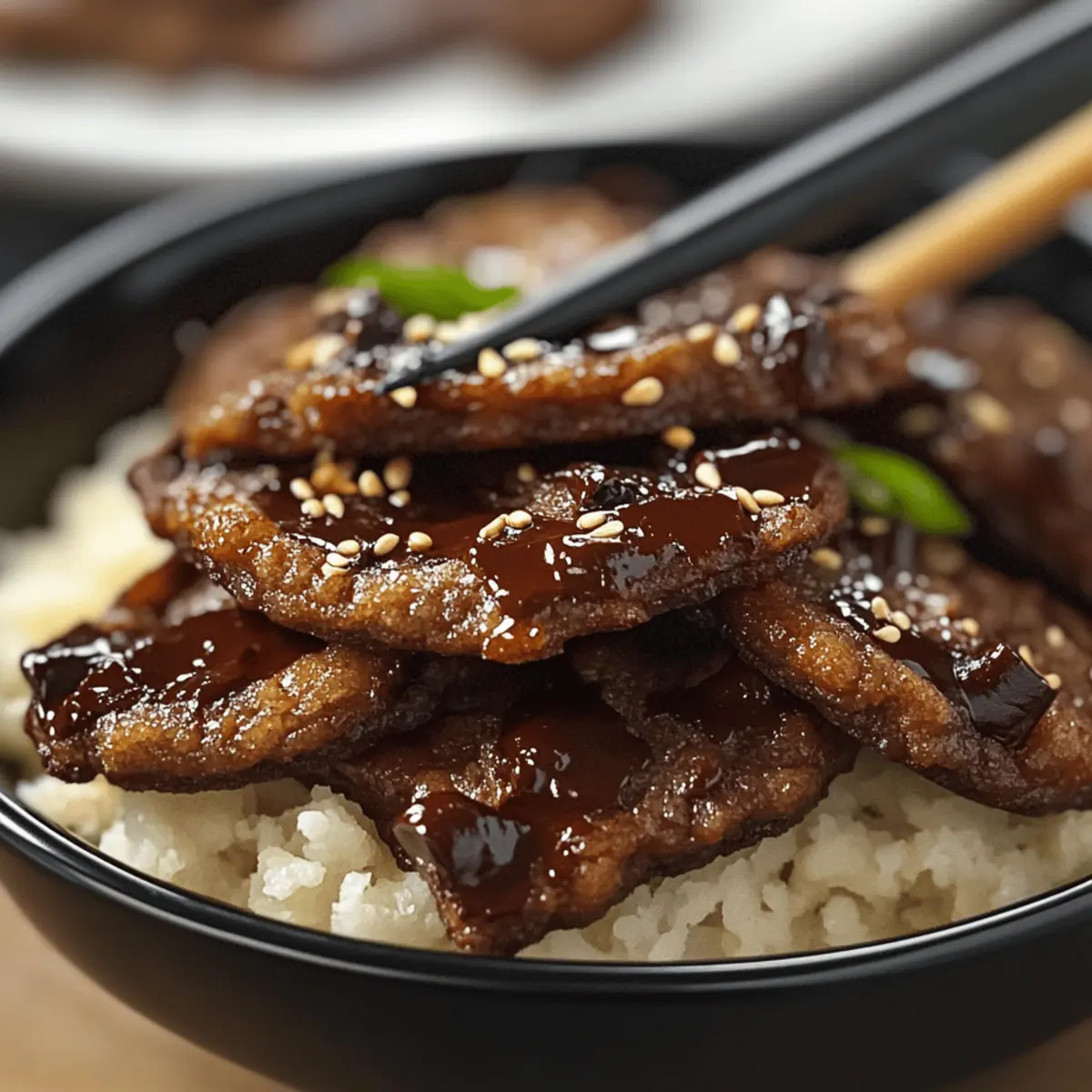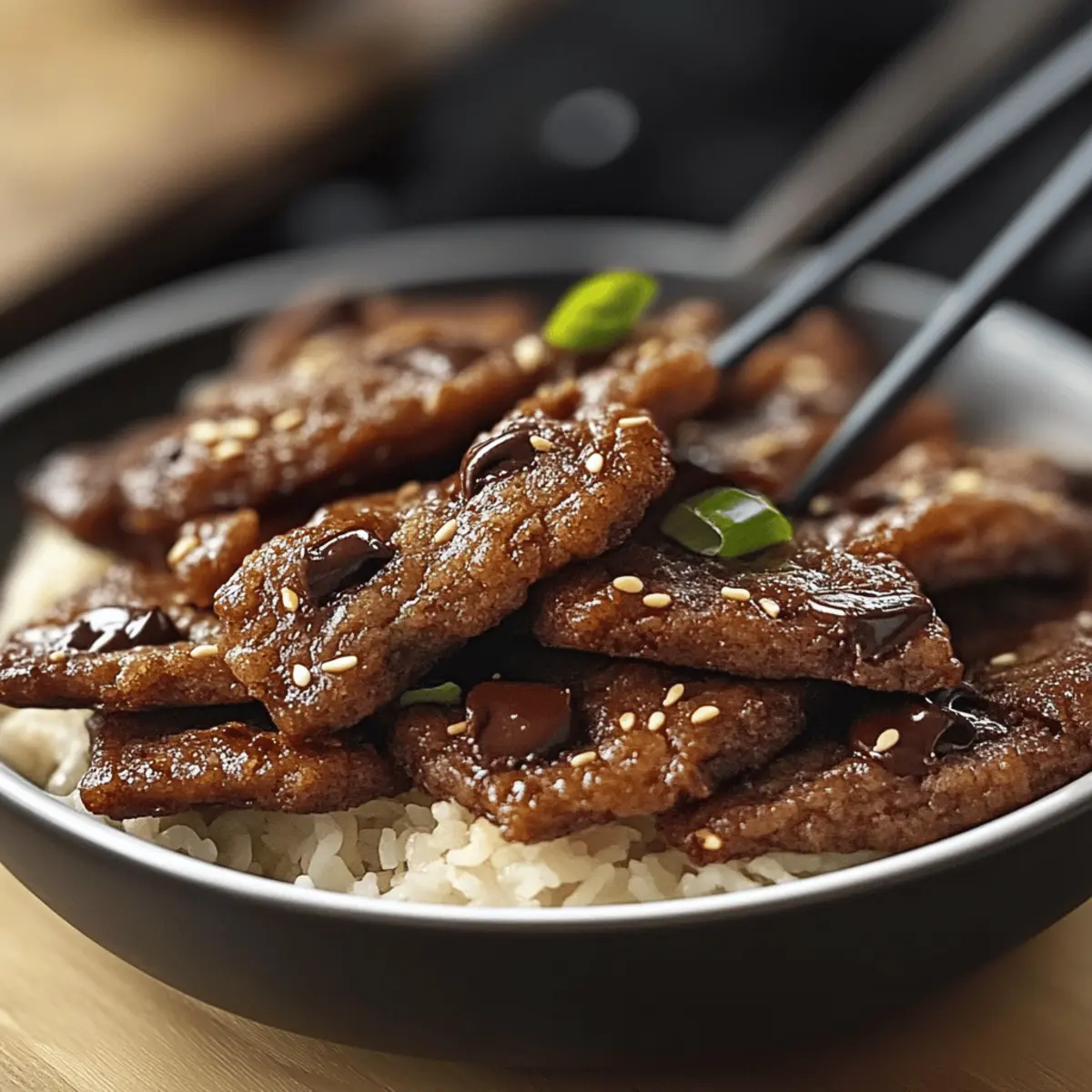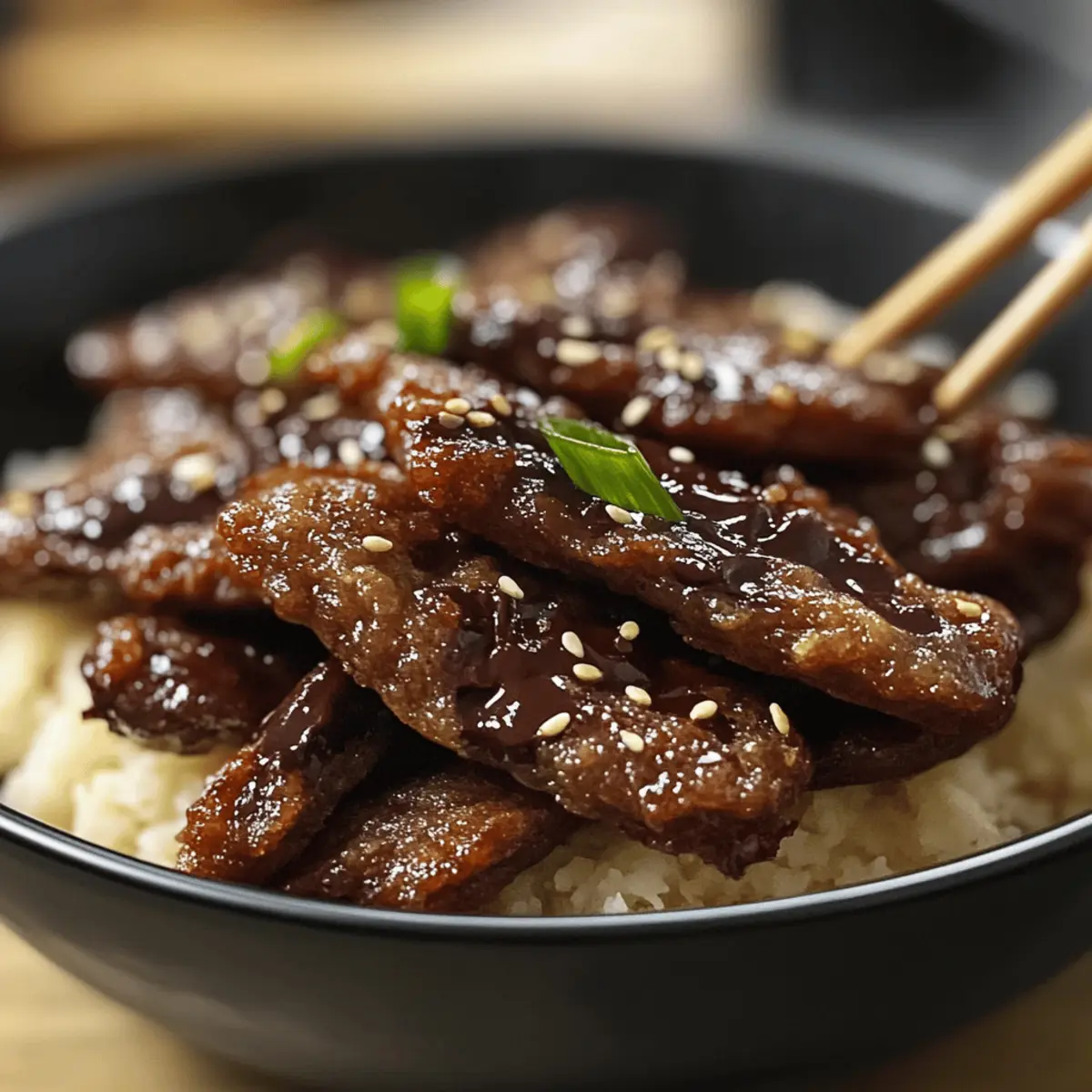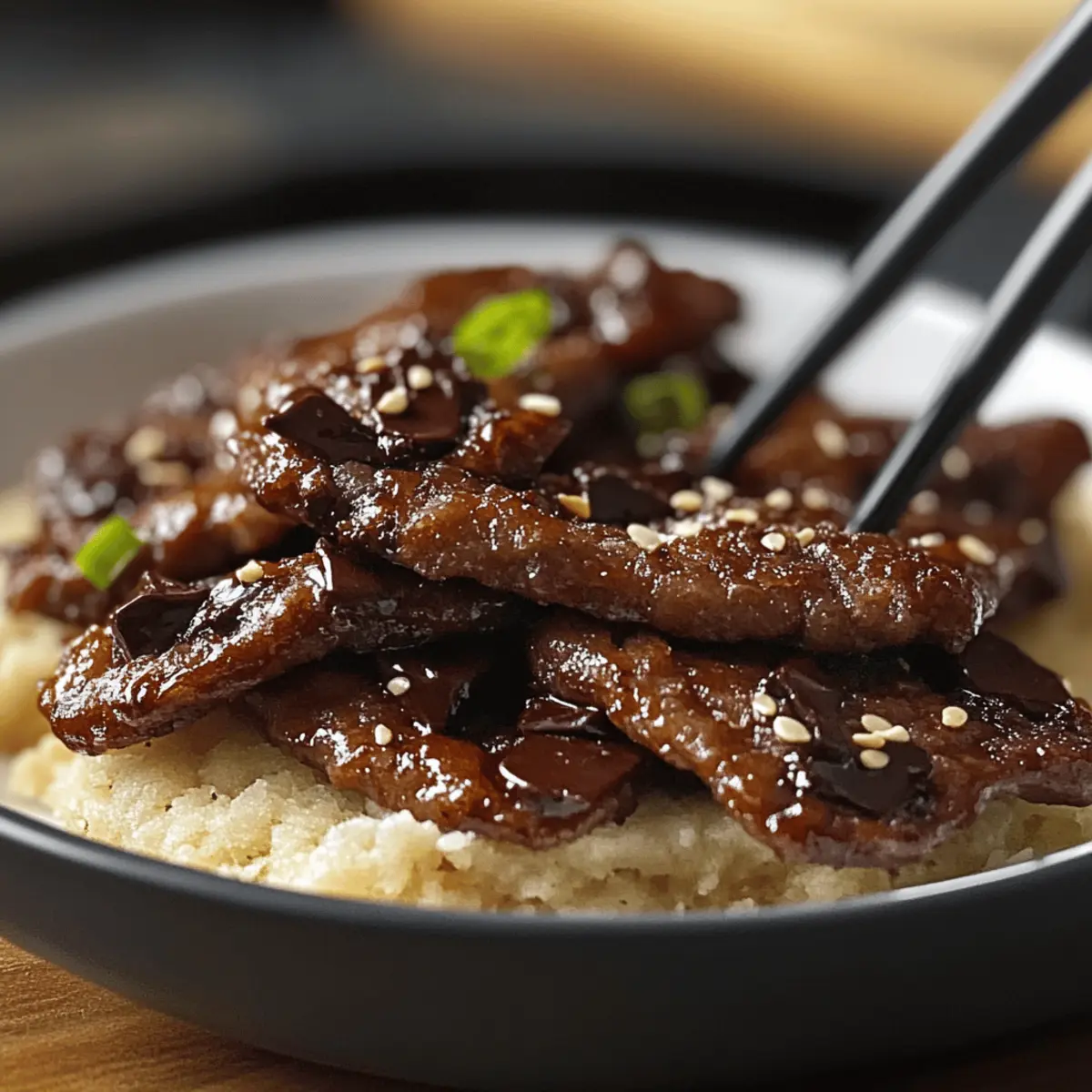The fragrant aroma of sizzling, marinated beef dances through my kitchen as I whip up a batch of Korean Beef Bulgogi. This classic dish never fails to transport me back to bustling Seoul markets, where the vibrant energy and tantalizing smells ignite a passion for cooking. Not only is this recipe incredibly easy to make, but it’s also perfect for a quick weeknight dinner that feels like a special occasion. The tender, flavorful slices of beef caramelize beautifully, creating a mouthwatering experience that will impress family and friends alike. Plus, it’s a fantastic way to incorporate fresh vegetables, making it a healthful and colorful addition to your dinner table. Are you ready to discover the secret to this stunning dish? Let’s dive into the steps to create your own unforgettable bulgogi!

Why Is Korean Beef Bulgogi a Must-Try?
Irresistible Flavor: The marinade melds garlic, soy sauce, and sesame oil, infusing the beef with a tantalizing taste that’s hard to resist.
Quick and Easy: In just 30 minutes, you can whip up a dinner that tastes like it was made by a professional chef.
Versatile Dish: Serve it over rice, in lettuce wraps, or alongside dishes like Korean Rice Balls for added variety.
Healthy Choice: Packed with tender beef and colorful vegetables, this dish is delicious and nutritious.
Crowd-Pleaser: Whether it’s a family dinner or a gathering with friends, this bulgogi will garner rave reviews. Get ready to impress!
Korean Beef Bulgogi Ingredients
For the Marinade
- Soy Sauce – A savory base that provides the essential umami flavor; low-sodium options are available for a healthier choice.
- Brown Sugar – Balances the saltiness and adds a touch of sweetness; can substitute with honey or agave for a natural alternative.
- Sesame Oil – Infuses a nutty fragrance that enhances the overall taste; you can use a blend of vegetable oil if unavailable.
- Garlic – Adds pungent depth; fresh minced garlic delivers the best flavor, but garlic powder is a suitable substitute in a pinch.
- Ginger – Brightens the marinade with a zesty kick; fresh ginger root works best, or use ground ginger for convenience.
For the Beef
- Thinly Sliced Beef – Use sirloin or ribeye for tenderness that soaks up the marinade beautifully; other cuts can be used but may require longer marination.
For Serving
- Green Onions – Garnish for an extra layer of flavor and color; can be omitted if you prefer a milder taste.
- Sesame Seeds – Sprinkled on top for crunch; to add a different texture, opt for toasted seeds for a nutty flavor.
- Lettuce Leaves – Use for wrapping the bulgogi; romaine or butter lettuce makes for delightful, fresh presentation.
This delightful aspect of Korean Beef Bulgogi surely brings a taste of Korea to your kitchen!
Step‑by‑Step Instructions for Korean Beef Bulgogi
Step 1: Preheat and Prepare
Begin by preheating your oven to 350°F (175°C) if you plan to roast the vegetables later. While it preheats, gather your ingredients and utensils: a large mixing bowl for the marinade and a cutting board for slicing your beef. Ensure your beef is thinly sliced, which will allow it to soak up the marinade flavors beautifully.
Step 2: Whisk the Marinade
In your mixing bowl, combine soy sauce, brown sugar, sesame oil, minced garlic, and freshly grated ginger. Whisk these ingredients together until the sugar has dissolved, creating a smooth marinade. The aromatic blend of the marinade will tantalize your senses, setting the stage for the delicious Korean Beef Bulgogi ahead.
Step 3: Marinate the Beef
Add your thinly sliced beef into the bowl, ensuring each piece is fully coated in the marinade. Cover the bowl with plastic wrap or a lid and let it marinate in the refrigerator for at least 30 minutes, allowing the flavors to penetrate the meat. If time permits, marinating for a few hours or overnight will deepen the taste.
Step 4: Prepare the Vegetables
While the beef marinates, slice your green onions and prepare any additional vegetables you’d like to serve—bell peppers and carrots work wonderfully. These can be sautéed quickly in a hot pan or served fresh alongside the bulgogi. Preparing now ensures everything is ready to cook right after marination.
Step 5: Cook the Beef
Heat a large skillet or grill pan over medium-high heat and add a touch of oil to prevent sticking. Once hot, add the marinated beef in a single layer. Cook for about 3-4 minutes on each side or until the beef is nicely caramelized and browned. The sizzling sound will confirm that you’re achieving that mouthwatering finish.
Step 6: Add Vegetables
If you’re cooking veggies, toss in your prepared green onions and any other vegetables during the last minute of cooking to lightly sauté them, allowing their flavors to meld with the beef. This step not only adds color to your dish but also enhances the overall taste of the Korean Beef Bulgogi.
Step 7: Garnish and Serve
Once the beef is cooked to perfection and the vegetables are tender-crisp, remove the skillet from the heat. Garnish your Korean Beef Bulgogi with a sprinkle of sesame seeds for added texture and flavor. Serve immediately with lettuce leaves for wrapping, and enjoy a vibrant and delightful meal that everyone will love!

What to Serve with Korean Beef Bulgogi
The vibrant flavors and tender textures of this dish create the perfect opportunity for delightful pairings to elevate your meal.
- Steamed Rice: A classic companion that absorbs the savory marinade, providing a comforting base to your bulgogi.
- Kimchi: This spicy fermented side dish adds a punch of flavor and a probiotic boost, enhancing the overall dining experience.
- Crispy Lettuce Wraps: Perfect for a fresh, hands-on approach, these wraps allow you to enjoy the bulgogi with added crunch and vibrancy.
- Grilled Vegetables: Serve alongside colorful veggies like bell peppers and zucchini that harmonize beautifully with the rich flavors of the beef.
- Pickled Carrots: Their tangy crunch adds a refreshing contrast, balancing the savory notes of the bulgogi and tempting your palate.
- Sooji (Korean Rice Cake): Soft and chewy, these rice cakes offer an enjoyable texture and can soak up the delicious flavors of the dish.
- Cold Noodle Salad: Refreshing and slightly tangy, this dish complements the warmth of the bulgogi while introducing a delightful cooling sensation.
- Sesame Spinach Salad: A light, nutritious option featuring sesame dressing that pairs well with the umami-rich beef flavors.
- Soju or Korean Beer: For a more authentic experience, these beverages enhance the meal with their crispness, creating a perfect pairing.
Variations & Substitutions for Korean Beef Bulgogi
Feel free to get creative with your Korean Beef Bulgogi by mixing up ingredients or adding extra flavors!
-
Gluten-Free: Use tamari instead of soy sauce for a gluten-free marinade without compromising on flavor.
-
Sweet and Spicy: Mix in gochujang (Korean chili paste) to the marinade for a delightful spicy kick. This twist adds depth and a lovely heat that truly elevates the dish!
-
Vegetarian Option: Substitute the beef with marinated tofu or seitan for a delicious meat-free experience that’s just as satisfying.
-
Herb Boost: Add fresh herbs like cilantro or mint as a garnish for a bright, refreshing finish. These herbs can bring an unexpected layer of flavor to your meal.
-
Fruit Infusion: Incorporate grated pear or apple into the marinade for additional sweetness and a hint of fruitiness that pairs beautifully with the savory beef.
-
Veggie Add-ins: Toss in colorful bell peppers and zucchini alongside the beef for a rainbow of nutrients. This not only enhances the dish’s appearance but adds delightful texture!
-
Different Cuts: Experiment with different cuts of beef, like flank or chuck roast, for a unique flavor and tenderness. Just adjust marination time as needed for varying thickness.
-
Serve with a Twist: Instead of traditional lettuce wraps, serve bulgogi in rice paper rolls for a fun alternative. These can make for light, bursting bites of flavor that everyone will love.
With these variations, you can customize your Korean Beef Bulgogi to suit your tastes or dietary needs—making every meal a new experience! Pair it with side dishes like Korean Rice Balls or a flavorful dessert like Korean Milk Cream for a complete feast!
How to Store and Freeze Korean Beef Bulgogi
Refrigerator: Store leftover Korean Beef Bulgogi in an airtight container in the refrigerator for up to 3 days. This keeps the beef tender and the flavors intact for your next meal.
Freezer: You can freeze marinated Korean Beef Bulgogi for up to 3 months. Just place the marinated beef in a freezer-safe bag, remove as much air as possible, and label with the date for easy access later.
Reheating: When ready to enjoy, thaw in the refrigerator overnight, then reheat in a skillet over medium heat until warmed through. This method ensures the beef remains juicy and delicious.
Serving Ideas: Serve reheated bulgogi with fresh veggies and rice for a quick and comforting meal that feels just as delightful as the first time around!
Expert Tips for Korean Beef Bulgogi
-
Slicing Technique: Ensure beef is thinly sliced against the grain for optimal tenderness and flavor absorption. This helps create a melt-in-your-mouth texture.
-
Marination Time: For the best flavor, marinate the beef for at least 30 minutes, but a few hours or overnight will deepen the flavors even more—trust me, it’s worth the wait!
-
Fresh Ingredients: Always use fresh garlic and ginger in your marinade for a truly authentic taste. Powdered substitutes can work, but nothing beats the aroma of fresh herbs.
-
High Heat Cooking: Cook on medium-high heat to achieve that beautiful caramelization without drying out the beef. This creates the signature flavor of Korean Beef Bulgogi.
-
Add-Ins: Consider tossing in other colorful vegetables, like bell peppers or mushrooms, during the last minute of cooking for added nutrition and visual appeal. This makes your bulgogi even more vibrant!
-
Serving Ideas: Serve your Korean Beef Bulgogi with rice, or use lettuce wraps for a fun, hands-on meal that invites everyone to dig in. Enjoy the robust flavors transporting you straight to Korea!
Make Ahead Options
These delicious Korean Beef Bulgogi are perfect for meal prep enthusiasts! You can marinate the beef up to 24 hours in advance, allowing the flavors to meld beautifully and create tender, savory meat. Simply mix your marinade and toss in the thinly sliced beef, then refrigerate it in an airtight container. For even more convenience, slice and prepare any vegetables you’d like to serve ahead of time—just keep them in the fridge for up to 3 days. When you’re ready to enjoy your meal, cook the marinated beef and any previously prepared veggies according to the original recipe instructions for an effortless and satisfying dinner. Enjoy restaurant-quality bulgogi with minimal effort!

Korean Beef Bulgogi Recipe FAQs
What type of beef is best for bulgogi?
For Korean Beef Bulgogi, thinly sliced sirloin or ribeye steak is ideal due to its tenderness and ability to soak up the marinade beautifully. If you have other cuts on hand, like flank steak or chuck, those can be used as well, but they may require a longer marination time for optimal flavor and tenderness.
How do I store leftover bulgogi?
Leftover Korean Beef Bulgogi can be stored in an airtight container in the refrigerator for up to 3 days. I love keeping it handy for quick lunches! Just make sure it’s cooled to room temperature before sealing it up. This will help maintain its juicy texture and savory flavor for your next meal.
Can I freeze Korean Beef Bulgogi?
Absolutely! You can freeze marinated Korean Beef Bulgogi for up to 3 months. Simply place the marinated beef in a freezer-safe bag, press out as much air as possible, and label it with the date. When you’re ready to enjoy it, thaw it in the refrigerator overnight before cooking. This way, the flavors remain intact and the beef stays moist.
How can I make bulgogi gluten-free?
To make a gluten-free version of Korean Beef Bulgogi, you can substitute regular soy sauce with tamari or a gluten-free soy sauce alternative. Additionally, ensure that any other sauces or ingredients, such as vinegar or sesame oil, are also gluten-free. This way, you won’t miss out on any flavor while enjoying this fantastic dish!
What vegetables pair well with bulgogi?
I often throw in colorful veggies like bell peppers, carrots, and zucchini when making Korean Beef Bulgogi for added nutrition and flavor. They add nice texture and freshness to the dish. If you’re planning to serve it in lettuce wraps, these vibrant veggies will really brighten up your meal!
How do I ensure my bulgogi has that great caramelization?
For that beautiful caramelization, it’s key to cook the marinated beef in a hot skillet over medium-high heat. This rapid cooking allows the sugars in the marinade to brown beautifully, creating a mouthwatering flavor. Avoid overcrowding the pan; cooking in batches helps achieve that perfect sear, maximizing taste and texture!

Mouthwatering Korean Beef Bulgogi That's Easy to Make at Home
Ingredients
Equipment
Method
- Preheat your oven to 350°F (175°C) if you plan to roast the vegetables later. Gather your ingredients.
- Combine soy sauce, brown sugar, sesame oil, minced garlic, and freshly grated ginger in a mixing bowl. Whisk until smooth.
- Add the thinly sliced beef into the marinade, ensuring it's fully coated. Cover and let marinate for at least 30 minutes.
- Slice your green onions and prepare additional vegetables like bell peppers and carrots.
- Heat a skillet over medium-high heat, add oil, and cook the marinated beef for about 3-4 minutes on each side.
- Add prepared green onions and any other vegetables during the last minute of cooking.
- Garnish the bulgogi with sesame seeds and serve immediately with lettuce leaves.

Leave a Reply